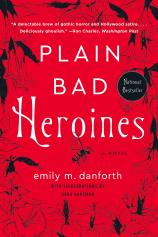Plain Bad Heroines
Review
Plain Bad Heroines
A story can be a doorway to a mirror, revealing a previously unknown reflection of oneself that seems all at once truer than any reflection ever has been before. This can be a lifesaving thing but also can be fraught with danger; for a queer person, an unruly woman or (imagine!) both, the world is not often a safe place for authenticity. Mary MacLane’s real-life book, I AWAIT THE DEVIL’S COMING, serves as this doorway to the many protagonists for Emily M. Danforth’s ambitious gothic novel.
PLAIN BAD HEROINES opens several doorways at once, a matryoshka narrative of sapphic desire and dread. It’s a story within a story within several stories, brimming with footnotes and asides, braiding its protagonists tightly around the ostensibly haunted Brookhants School for Girls. The book opens at Brookhants in 1902, in the thick of a late Rhode Island summer. Two students in love, Flo and Clara, die gruesome deaths in each other’s arms at the stingers of hundreds of yellow jackets. Within the same semester, another student is found dead in the school’s Orangerie, having consumed certain poisonous flowers. Mary MacLane’s book is found at both scenes.
"Revel in the uncanny strangeness of its premise, its languorously practiced execution, the sweet rot of the orchard, and the gentle hum of ceaseless, nearing dread.... Some stories are doorways, and this one is a puzzle box that opens to a tangle of vines, ominous and inviting, with defiant queer women at its core."
Published when MacLane was 19, I AWAIT THE DEVIL’S COMING is (in real life) infamous for its controversy as well as its confessional nature, which includes the author’s desire to marry the devil and her attraction to other women. It’s this latter bit that clung to the students, as well as to the school’s young headmistress, Libbie, and her eventual partner. Libbie met Alex at school when she was known as Alex the Flirt, but as circumstances elide and Libbie finds herself the headmistress of a school bereft with increasingly disturbing happenings, a rift develops between her and Alex just when, it turns out, they need each other the most.
Over a hundred years later, a descendent of Brookhants inspires a young writer, encouraging her to write about the sordid events of the school. Merritt, reeling from her father’s suicide, takes up this task and to great acclaim. Five years after publication, The Happenings at Brookhants is being turned into a movie by visionary director Bo Dhillon, who asks Merritt to consult. Flo and Clara are played by Harper Harper, a girl-next-door turned Insta-famous, effortlessly attractive celesbian, and earnest B-list actress Audrey Wells, best known for her mother’s former scream queen antics. But as the three 20-somethings settle in at Brookhants to tell the story of the strange, century-old queer tragedy, odd and tragic things begin to unfold in their own lives. Things that can’t be explained, not even, perhaps, by the secret Bo has asked Audrey to keep. Things that suggest the rumors of Brookhants’ curse might need to be taken seriously.
PLAIN BAD HEROINES alternates between Libbie and Alex’s story, and the trio of girls making the film in present-day. In both timeframes, across generations, queer women star. They fall desperately in love, are terrible to each other, keep secrets, treat each other with utmost tenderness, and endure the brutality of the Brookhants curse. Danforth crafts a palimpsest on the apple-soaked, menacing grounds of the school, blending the then and the now. It’s a story about the filming of a movie based on a book about an in-world real-life event, all centered on an actual real-life book. It’s a dizzying kaleidoscope of sapphic desire, sorrow and strangeness, wrapped within meditations on how narratives influence each other, why we read horror and who gets to tell our stories.
Danforth pays homage to gothic horror, even including illustrations by Sara Lautman, centering complex queer women across generations. She revels in the genre’s unreliable narration, blending it with the constructed fabrication of social media posts and meta-mockumentary, leaving her characters and her readers questioning what, after all, is real. Knowing that Danforth’s beloved novel, THE MISEDUCATION OF CAMERON POST, was recently adapted into a film adds another level of metatext, as well as encourages readers to peer extra keenly at Merritt’s experiences on set.
PLAIN BAD HEROINES is a celebration of complex lesbians and disastrously delightful queer women. Because this is a very long book and there are so very many characters, it does stand out that they are very white. I don’t mind this, but I did find myself wishing the novel felt a bit more aware of its whiteness, especially as it moves through time and the unnamed narrator is so very aware of everything else.
It’s a lengthy but haunting read. Don’t expect a tidy ending, not for the novel or for any of its characters. Revel in the uncanny strangeness of its premise, its languorously practiced execution, the sweet rot of the orchard, and the gentle hum of ceaseless, nearing dread. Let the thrill of parallels wash over you, the nascent desire a thing with claws.
Some stories are doorways, and this one is a puzzle box that opens to a tangle of vines, ominous and inviting, with defiant queer women at its core.
Reviewed by Maya Gittelman on October 30, 2020




